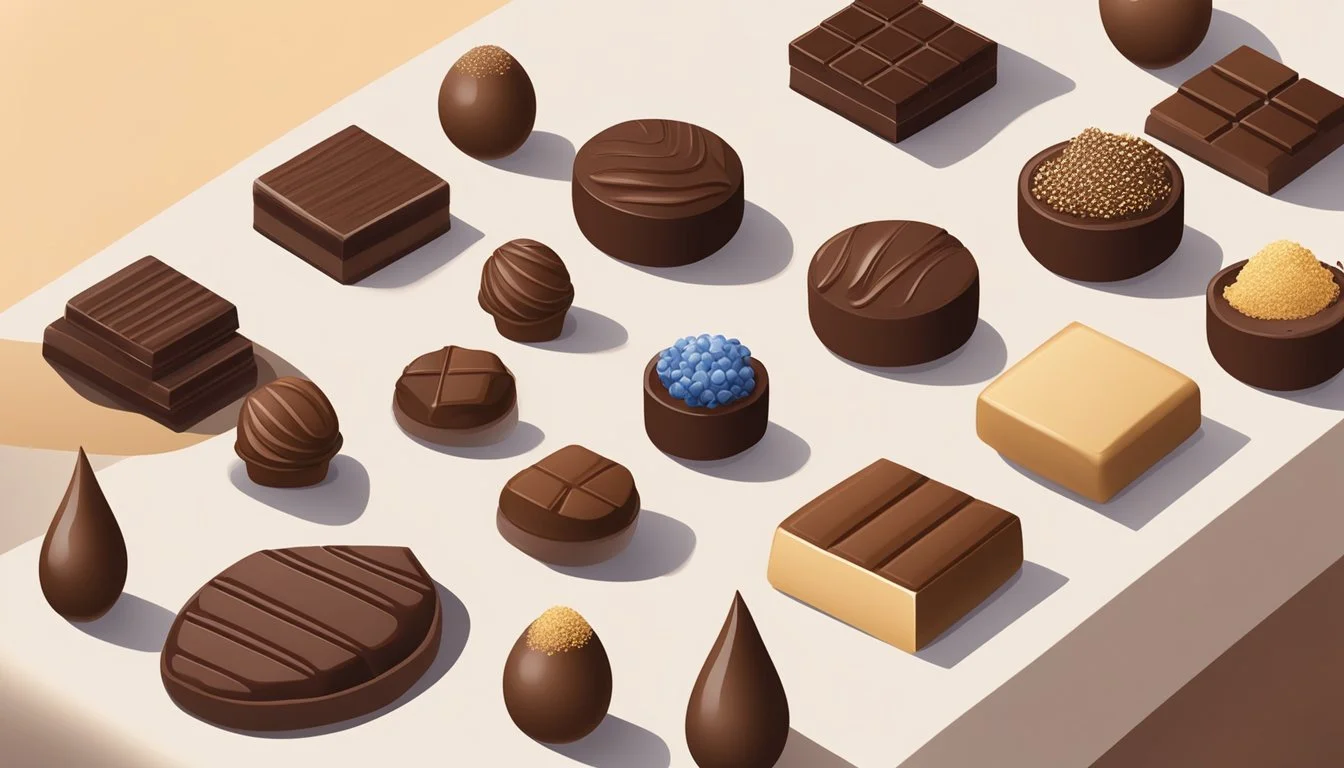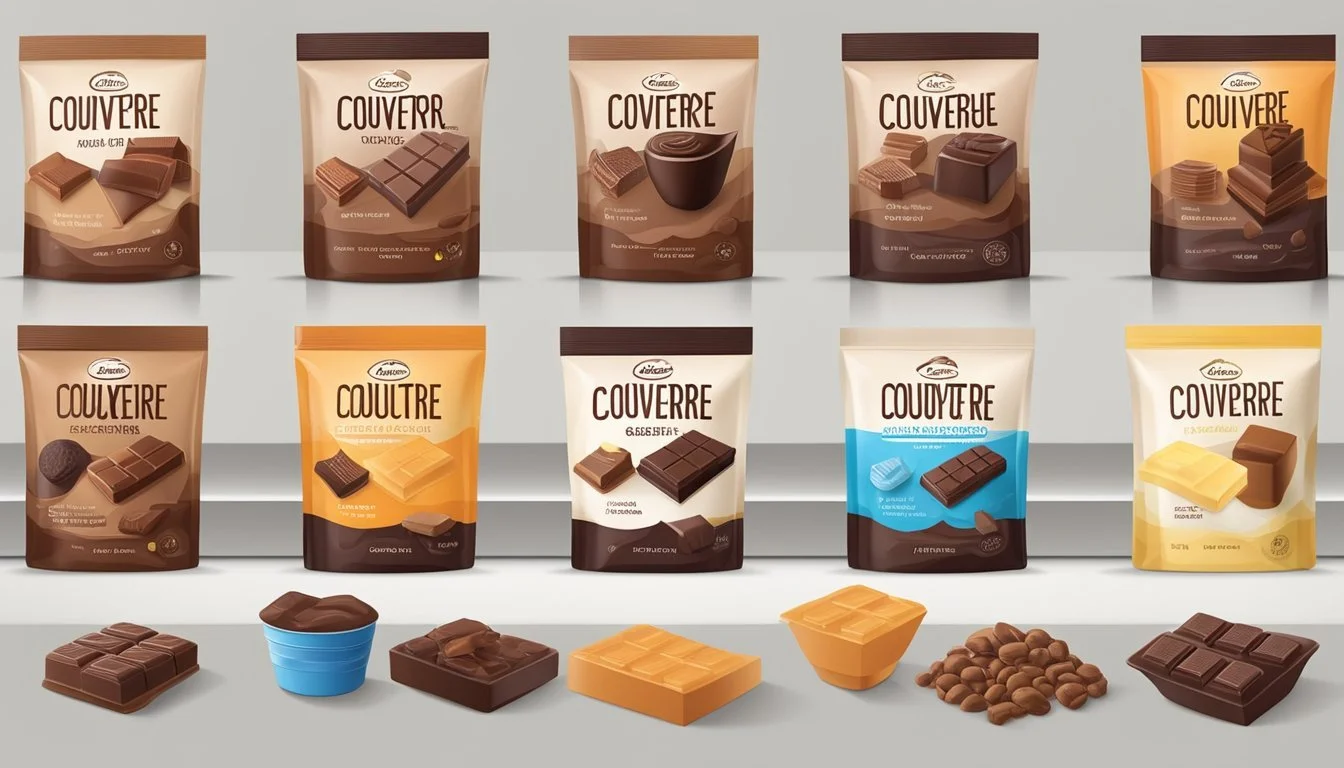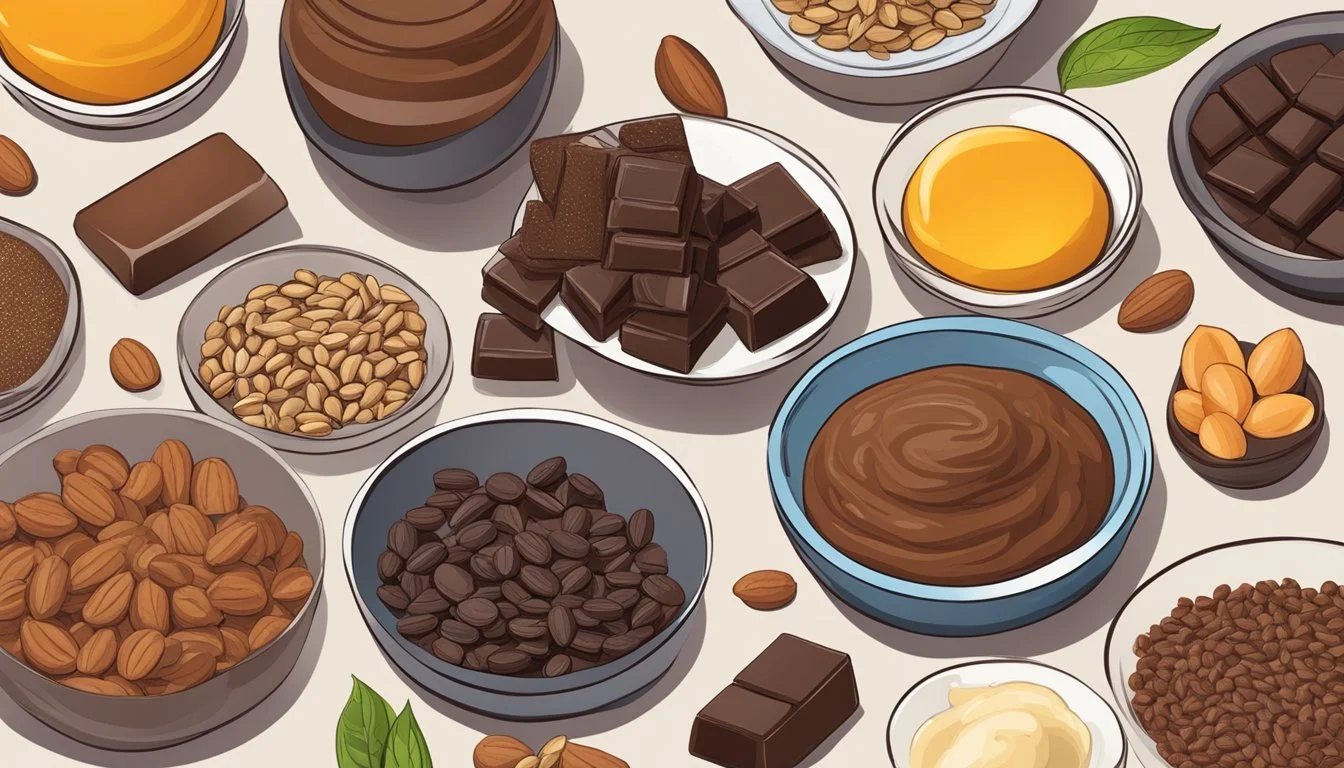Couverture Chocolate Substitutes
Best Alternatives for Baking and Confections
Couverture chocolate, known for its high cocoa butter content and fine texture, is a favorite among professional bakers and chocolatiers. However, finding a suitable substitute is not always straightforward. For those looking to replicate the luxurious flavor and smooth texture of couverture chocolate, options such as black chocolate, coated chocolate, and bitter chocolate can be effective substitutes.
When substituting for couverture chocolate, it's crucial to consider the cocoa butter content and the intended use in baking or confectionery. Regular supermarket chocolate with similar cocoa content can also work, though adjustments might be needed to manage the fat content in the recipe. This ensures that the final product maintains the desired consistency and richness.
For specific applications like making chocolate-covered strawberries or holiday candies, chocolate compounds might offer a convenient alternative. These compounds don’t require tempering, making them easier to work with, though they might lack the same snap and sheen as properly tempered couverture chocolate. Always choose quality ingredients to achieve the best results in your culinary creations.
Understanding Couverture Chocolate
Couverture chocolate is a high-quality chocolate known for its specific properties. It's distinct from regular chocolate due to its higher percentage of cocoa butter, which typically ranges from 32% to 39%. This higher fat content is crucial as it contributes to the chocolate's smooth texture and ease of melting.
The cocoa solids in couverture chocolate are another defining factor. These solids come from the cocoa bean and are integral to the chocolate's rich flavor. Couverture chocolate usually contains around 54% cocoa content, combining both cocoa butter and cocoa solids.
One significant feature of couverture chocolate is its ability to temper well. Tempering is a process used to heat and cool chocolate to stabilize it for making confections. Properly tempered couverture chocolate has a beautiful shine and a satisfying snap when broken.
Here is a comparison table to highlight key differences:
Feature Couverture Chocolate Regular Chocolate Cocoa Butter 32-39% Lower than 32% Cocoa Solids Higher Lower Tempering Excellent Good Shine High Moderate Snap Sharp Softer
Couverture chocolate is ideal for making pastries, bonbons, and other confections. The high cocoa butter content allows it to melt faster, making it easier to work with. This results in a product that not only tastes superior but also has a professional finish.
Choosing Substitutes Based on Use-Case
Selecting the right substitute for couverture chocolate depends on what you're using it for, such as baking, coating, or flavor and texture preferences. Each use-case requires a different approach to ensure the best results.
Baking Needs
For baking, the key factors are cocoa content and fat composition. Bakers often turn to fine baking chocolate, which may be more suitable for recipes needing high cocoa butter content. Alternatively, regular supermarket chocolate with similar cocoa content can be adjusted by modifying other fats in the recipe. Dark chocolate is another option, as it typically contains higher cocoa solids, enhancing the flavor profile of baked goods.
Coating and Dipping
When it comes to coating and dipping, texture and melt quality are paramount. Compound chocolate coating can be a suitable alternative, offering ease of use without the need for tempering. It’s widely used by professionals for glazing cakes and coating confections. Additionally, milk chocolate with a high cocoa butter content can achieve a smooth finish and firm set, ideal for covering truffles or other candies.
Flavor and Texture Preferences
Flavor and texture play a significant role in personal preference. For a smooth and creamy texture, milk chocolate offers a good balance of sweetness and creaminess due to its high dairy content. Conversely, those who prefer an intense chocolate flavor might opt for dark chocolate with a higher percentage of cocoa solids. In some cases, carob powder can serve as a non-chocolate alternative, providing a distinct, mildly sweet flavor and a soft texture.
Kinako (soybean powder) is another option for a unique, nutty flavor, often used in traditional Japanese desserts. Personal taste greatly influences the choice of substitute, dictated by the desired richness, sweetness, and mouthfeel.
Common Couverture Alternatives
When couverture chocolate isn't available, there are several effective substitutes that can be used in baking and confectionery. Each alternative has its own characteristics, making it important to choose the right one for your specific needs.
Dark and Milk Chocolate Variants
Dark Chocolate:
Dark chocolate serves as a practical substitute for couverture. With its high cocoa content, it offers a rich flavor profile. While it may have less cocoa butter than couverture, adjusting other fats in the recipe can compensate for this. Melted dark chocolate is ideal for brownies and ganache.
Milk Chocolate:
Milk chocolate has a sweeter and creamier taste compared to dark chocolate. It can be used as a substitute, though it may change the flavor and texture. This makes it suitable for less intense chocolate desserts. Using high-quality milk chocolate ensures a better result.
Chocolate chips, particularly those used in baking, can also act as a replacement. They typically contain stabilizers that prevent them from melting smoothly, so they might not be ideal for tempering. Instead, they work well in cookies and quick desserts.
White Chocolate Solutions
White Chocolate Bars:
White chocolate, made from cocoa butter, milk solids, and sugar, can replace couverture in non-chocolate recipes that require a smooth, creamy texture. It doesn’t contain cocoa solids, so it offers a different flavor. This makes it a good choice for making desserts like white chocolate mousse or ganache.
Compound White Chocolate:
Compound chocolate, which contains vegetable fats instead of cocoa butter, can be used where precise tempering isn't needed. Though it lacks the richness of couverture, it works well in coatings and decorations, providing a decent texture and shine without the need for tempering.
Non-Chocolate Options
Carob Powder:
For those seeking non-chocolate alternatives, carob powder is an option. Derived from the carob tree, it has a naturally sweet and slightly earthy flavor. It can replace cocoa powder in recipes, though the taste will be different. Carob is often used in dietary-specific recipes.
Molasses:
Molasses, a by-product of sugar extraction, can substitute cocoa powder in certain baked goods. Though it brings a smoky-sweet flavor, it will significantly alter the taste of your recipe. This makes it suitable for specific baked items like dark breads and dense cakes.
By considering these substitutes and their unique properties, you can find the best alternative for your particular chocolate needs.
Custom Substitutes for Specific Qualities
When substituting couverture chocolate, it is crucial to tailor the swaps to specific qualities such as fat content, sweetness, texture, melting point, color, and gloss. This approach ensures that the substitute performs similarly to couverture chocolate in various culinary applications.
Fat and Sweetness Adjustment
Fat and sweetness are pivotal elements in chocolate. Couverture chocolate typically contains high cocoa butter content and balanced sweetness. For those needing to adjust these attributes, dark chocolate bars are a good starting point, given their high cocoa content.
To increase fat, one might add a little butter or vegetable oil. For sweetness adjustments, adding sugar or using sweeter chocolates like milk chocolate can help. Adjusting fat and sweetness is particularly important in recipes like truffles, where the balance profoundly affects the final product's richness and flavor.
Texture and Melting Point Modification
The texture and melting point of chocolate can be critical for applications like molding or enrobing. Couverture chocolate is known for its smooth texture and good melt. To modify texture, one can combine semi-sweet chocolate with a small amount of cocoa butter.
Melting points can be adjusted by blending different chocolates. For a smoother melt, adding coconut oil can help as it has a low melting point which ensures the chocolate melts evenly when heated. These adjustments ensure the substituted chocolate behaves as intended, especially in finely crafted desserts.
Color and Gloss Enhancement
Color and gloss are essential for aesthetics in finished chocolate products. Couverture chocolate often has a deep, rich color and a good sheen. Using high-quality dark chocolate helps maintain a close color match.
For enhanced gloss, temper the chocolate correctly and possibly incorporate a small amount of vegetable shortening or cocoa butter. Proper tempering during the melting and cooling process creates a shiny finish and a good snap. This is vital when presentation matters, such as in chocolate decorations or candy coatings.
By focusing on these specific qualities, one can effectively substitute couverture chocolate while maintaining the desired characteristics and performance in culinary applications.
DIY Couverture Chocolate Mix
Creating a homemade substitute for couverture chocolate is a practical option for those who want to maintain a high-quality chocolate experience. The key to this mix is the balance of cocoa butter and cocoa solids.
Ingredients:
150g cocoa butter
200g cocoa powder
100g powdered sugar (optional for sweetness)
A pinch of lecithin (optional, for better texture)
Instructions:
Melt the Cocoa Butter: Gently melt the cocoa butter in a double boiler until fully liquefied.
Mix the Ingredients: Add the cocoa powder to the melted cocoa butter. Stir until smooth.
Add Sweetness (Optional): If desired, mix in the powdered sugar, ensuring it fully dissolves.
Improve Texture (Optional): For a smoother texture, add a pinch of lecithin.
Temper the Chocolate: Tempering is crucial for a shiny finish and proper snap.
Temperature Guide Method Melt to 45°C (113°F) Stir consistently until fully melted. Cool to 27°C (80.6°F) Pour onto a cool surface or add tempered chocolate Heat to 32°C (89.6°F) for dark Gradually warm up while stirring continuously.
Use Immediately: Use this mix for dipping, molding, or any recipe requiring couverture chocolate.
Adhering to these steps ensures that the DIY couverture chocolate mix retains the characteristics of store-bought couverture, offering professional quality at home.
Commercial Substitutes and Brands
When searching for substitutes for couverture chocolate, several commercial options are available. These alternatives vary in quality and usage, making it essential to choose wisely.
Callebaut offers a range of chocolate products that serve as substitutes for couverture chocolate. Known for its smooth texture, Callebaut's baking chocolate maintains a high cocoa content and matches the richness required for gourmet recipes.
Guittard is another prominent brand, offering premium chocolate that can effectively replace couverture chocolate. Guittard's bittersweet and semisweet chocolates are ideal for baking and provide the necessary melt and consistency.
Valrhona stands out in the market as a high-quality option. Used by many pastry chefs, Valrhona's chocolate has a fine grind and a high cocoa butter content, making it a top choice for couverture substitutes.
Other brands also offer compound chocolate coatings which can serve as a replacement. These products typically contain substitutes such as vegetable fats instead of cocoa butter, making them more affordable but less luxurious.
Recommended Substitutes at a Glance
Brand Substitute Type Key Features Callebaut Baking Chocolate High cocoa content, smooth texture Guittard Bittersweet/Semisweet Premium quality, suitable for baking Valrhona Fine Baking Chocolate High cocoa butter content, fine grind Generic Compound Chocolate Coating Affordable, uses vegetable fats
For best results, choose a substitute that closely matches the cocoa content and texture of couverture chocolate. This ensures the desired outcome in both taste and appearance of your culinary creations.
Understanding Labels and Chocolate Standards
Labeling couverture chocolate and its substitutes involves adhering to various standards that govern the ingredients and composition of these products.
In America, the Food and Drug Administration (FDA) regulates chocolate under Title 21 of the Code of Federal Regulations (CFR). This requires all ingredients in chocolate products, like sweeteners and emulsifiers, to be disclosed on the label.
Couverture chocolate must meet specific criteria to be labeled as such. According to the Codex Alimentarius standards, it must contain a minimum of 35% total cocoa solids, with at least 31% being cocoa butter and 2.5% fat-free cocoa solids.
Different countries have their own standards. For example, the Codex Standard for Chocolate and Chocolate Products (CXS 87-1981) outlines precise definitions and minimum content requirements for various types of chocolate, including couverture.
Compound chocolate often faces a labeling dilemma, as it uses vegetable fats instead of cocoa butter. This difference affects both the labeling and the allowed descriptors of the product. It is important for consumers to check the labels carefully to understand what type of chocolate they are purchasing.
Here is a quick comparison:
Aspect Couverture Chocolate Compound Chocolate Cocoa Solids ≥ 35% Varies Cocoa Butter ≥ 31% Uses vegetable fats Standards Strict, standardized More lenient
Accurate labeling helps consumers make informed choices, particularly about the quality and composition of the chocolate products they are buying.
Culinary Techniques with Substitutes
When using substitutes for couverture chocolate, some modifications in culinary techniques are beneficial. This section discusses tempering alternatives and adjustments needed in baking and mixing processes.
Tempering Alternatives
Tempering couverture chocolate ensures a glossy finish and a firm snap. Substitutes like compound chocolate do not require the same precise tempering as couverture chocolate because of different fat contents.
To temper compound chocolate, heat it to 110°F (43°C), then cool it to 84°F (29°C). Reheat slightly to 88°F (31°C) before use.
Regular chocolate may need more precise temperature control, reaching 113°F (45°C) initially, cooling to 82°F (28°C), and then reheating to 90°F (32°C).
Baking and Mixing
In baking, substitutes affect texture and flavor. For instance, lower cocoa butter content in supermarket chocolate requires adjustments.
Common techniques:
Varying fat: Increase butter or oil to compensate for reduced cocoa butter.
Chopping: Use finely chopped substitutes for smoother mixing.
Suitability:
Black chocolate for rich flavor.
Coated chocolate for a consistent melt.
Bitter chocolate for intense cocoa notes.
Select substitutes wisely to maintain recipe integrity, ensuring the substitute aligns with intended heat tolerance and flavor profile.
Troubleshooting Common Issues
When substituting couverture chocolate, several challenges can arise such as texture inconsistencies, flavor mismatches, and difficulties with melting and binding. Each issue requires specific solutions to achieve the desired result in your chocolate creations.
Texture Challenges
Texture issues often emerge when the substitute chocolate has a different fat content from the original couverture chocolate. To maintain a smooth texture, ensure that the alternative has a similar cocoa butter content.
If the substitute has less cocoa butter, consider adding a small amount of butter or cocoa butter to the recipe. This adjustment helps in achieving a similar mouthfeel. Additionally, properly tempering the chocolate is crucial as it influences texture.
Under-tempered chocolate may appear grainy or dull. Avoid overheating during the tempering process as it can destabilize the fat content, leading to a coarse texture.
Flavor Mismatch
Couverture chocolate has a distinct flavor profile due to its high cocoa content and quality ingredients. When using substitutes, it’s essential to select chocolates with a similar balance of cocoa solids and sugar.
Cheap or inferior quality chocolate can result in a noticeable flavor difference. For the best results, choose high-quality dark, bittersweet, or semi-sweet chocolates with a comparable cocoa percentage.
If the substitute chocolate still doesn't meet flavor expectations, incorporating a bit of vanilla extract or a pinch of salt can help balance the taste. These adjustments can mitigate slight differences and enhance the overall flavor.
Melting and Binding Difficulties
Melting substitute chocolate can present difficulties if it contains different stabilizers or fat compositions. Use a double boiler or microwave in short bursts to gently melt the chocolate, avoiding any direct or high heat which can scorch it.
Maintaining the right temperature throughout the melting process is key to achieving a smooth, cohesive mixture. Improper melting can lead to separation of fats or a gritty consistency.
If binding becomes an issue, adding a teaspoon of neutral oil, such as vegetable or coconut oil, can improve the consistency. This addition helps the chocolate bind well with other ingredients in your recipe, ensuring a uniform mixture suitable for enrobing or dipping.
Health and Dietary Considerations
When seeking substitutes for couverture chocolate, it's essential to consider health and dietary needs. Alternatives can address requirements like low-fat content or sugar-free options, and dietary preferences such as vegetarian or vegan.
Low-Fat and Sugar-Free Alternatives
For those monitoring their fat intake, finding a low-fat alternative is crucial. Carob is a popular choice, as it contains 0.6 grams of fat per tablespoon compared to 1.5 grams in cocoa powder. Carob is also naturally sugar-free, making it suitable for those avoiding added sugars.
Another option is black chocolate with high cocoa content, typically containing less sugar. Almond butter mixed with cocoa powder offers a lower-fat, no-sugar alternative and can be used in various recipes. Including cream of tartar, juice, or vinegar can adjust the sweetness to taste.
Vegetarian and Vegan Options
For vegetarians and vegans, ensuring that chocolate alternatives are free from animal products is a must. Bitter chocolate and high-percentage dark chocolate are dependable choices, as they often lack dairy ingredients.
Carob is another excellent substitute since it is naturally free from dairy and other animal-derived substances. Additionally, almond butter combined with cocoa provides a vegan-friendly option, enhancing the flavor profile without compromising dietary restrictions.
Cocoa butter alternatives, such as coconut oil or vegetable shortening, can replicate the texture of couverture chocolate in vegan recipes. Always check labels carefully to confirm that products meet dietary specifications.







